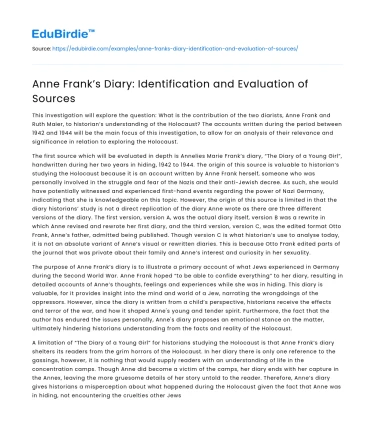This investigation will explore the question: What is the contribution of the two diarists, Anne Frank and Ruth Maier, to historian’s understanding of the Holocaust? The accounts written during the period between 1942 and 1944 will be the main focus of this investigation, to allow for an analysis of their relevance and significance in relation to exploring the Holocaust.
The first source which will be evaluated in depth is Annelies Marie Frank’s diary, “The Diary of a Young Girl”, handwritten during her two years in hiding, 1942 to 1944. The origin of this source is valuable to historian’s studying the Holocaust because it is an account written by Anne Frank herself, someone who was personally involved in the struggle and fear of the Nazis and their anti-Jewish decree. As such, she would have potentially witnessed and experienced first-hand events regarding the power of Nazi Germany, indicating that she is knowledgeable on this topic. However, the origin of this source is limited in that the diary historians’ study is not a direct replication of the diary Anne wrote as there are three different versions of the diary. The first version, version A, was the actual diary itself, version B was a rewrite in which Anne revised and rewrote her first diary, and the third version, version C, was the edited format Otto Frank, Anne’s father, admitted being published. Though version C is what historian’s use to analyse today, it is not an absolute variant of Anne’s visual or rewritten diaries. This is because Otto Frank edited parts of the journal that was private about their family and Anne’s interest and curiosity in her sexuality.
Save your time!
We can take care of your essay
- Proper editing and formatting
- Free revision, title page, and bibliography
- Flexible prices and money-back guarantee
The purpose of Anne Frank’s diary is to illustrate a primary account of what Jews experienced in Germany during the Second World War. Anne Frank hoped “to be able to confide everything” to her diary, resulting in detailed accounts of Anne’s thoughts, feelings and experiences while she was in hiding. This diary is valuable, for it provides insight into the mind and world of a Jew, narrating the wrongdoings of the oppressors. However, since the diary is written from a child’s perspective, historians receive the effects and terror of the war, and how it shaped Anne's young and tender spirit. Furthermore, the fact that the author has endured the issues personally, Anne's diary proposes an emotional stance on the matter, ultimately hindering historians understanding from the facts and reality of the Holocaust.
A limitation of “The Diary of a Young Girl” for historians studying the Holocaust is that Anne Frank’s diary shelters its readers from the grim horrors of the Holocaust. In her diary there is only one reference to the gassings, however, it is nothing that would supply readers with an understanding of life in the concentration camps. Though Anne did become a victim of the camps, her diary ends with her capture in the Annex, leaving the more gruesome details of her story untold to the reader. Therefore, Anne’s diary gives historians a misperception about what happened during the Holocaust given the fact that Anne was in hiding, not encountering the cruelties other Jews were experiencing.
The second source which will be evaluated in depth is Ruth Maier’s diary, “A Young Girl’s Life Under Nazism”, comprising entries ever since 1933 to her death in Auschwitz in 1942. The origin of this source is valuable to historian’s studying the Holocaust because it is a record written and delivered by Ruth Maier herself, a refugee from Austria. Ruth Maier’s accounts provide historians with a valuable body of evidence about Ruth’s life, revealing her personality and emotions, but also insight into the world situation before and during the Second World War. Additionally, the date of origination of the accounts, 1933, indicates that the source allows for a valuable understanding of how the lives of ordinary people before the war were affected by matters beyond their control. In terms of origin, this source is limited in that the diary historian’s read is not the spontaneous material in its first and only draft, never intended for publication. Ruth Maier’s diary had been edited by Jan Erik Vold before it was published, and therefore possibly omits and modifies the tone of the original text containing details of her slightly subjective insight and views of Nazis.
The purpose of this source, similar to Anne Frank’s diary, is to exhibit the affliction of what Jews underwent as they promptly fell victim to the rise of Hitler and Nazi Germany. This diary, therefore, is valuable for it proposes insight into the realm of Jews who, like Ruth Maier, “believe things are going to get tough” as the war proceeds. This source, however, is limited in its purpose in that it hides readers from the worst, making them assume they have confronted the Holocaust without being tormented by extreme images as Ruth Maier’s diary abruptly ends shortly before her capture and death upon arrival in Auschwitz in 1942.






 Stuck on your essay?
Stuck on your essay?

